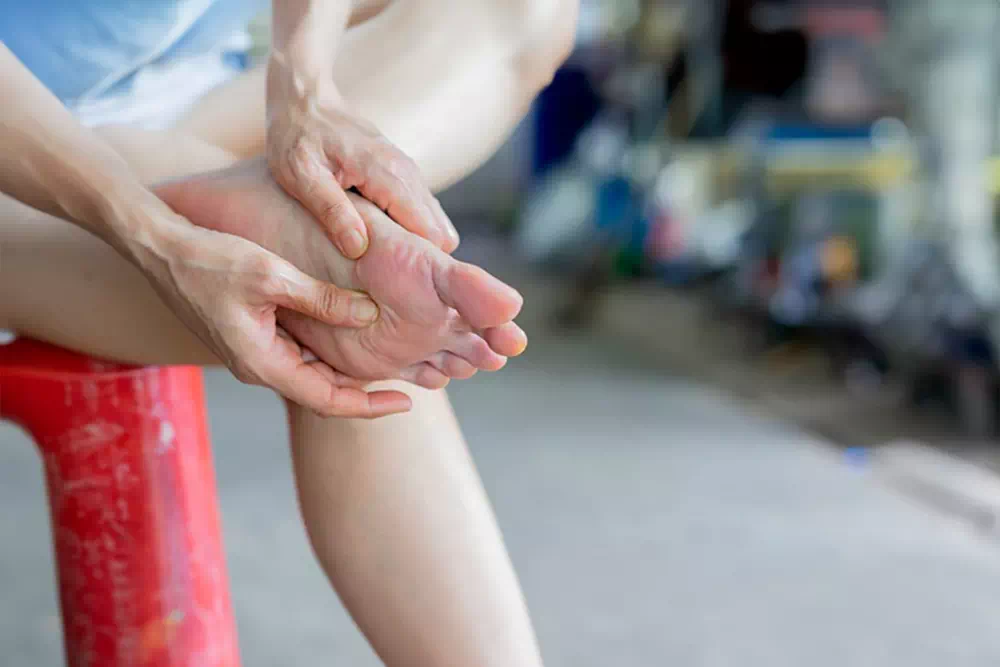Osteoarthritis of the foot is characterised by the progressive degradation of the articular cartilage, leading to symptoms such as pain, stiffness, swelling, reduced mobility, joint deformities, and crepitus. The pain, often worsened during or after physical activity, can limit participation in certain activities. Bone spurs may form in the advanced stages
OSTEOARTHRITIS OF THE FOOT CAN BE CAUSED BY SEVERAL FACTORS, INCLUDING:
- Natural ageing
- Previous foot injuries
- Structural abnormalities (flat feet, high arches)
- Overuse and repetitive movements
- Obesity
- Genetic factors
- Inflammatory arthritis (rheumatoid arthritis)
Understanding the specific causes is crucial for developing a treatment plan tailored to each individual and the severity of the condition. A consultation with a healthcare professional is necessary for an accurate diagnosis and appropriate management.
HOW TO KNOW IF I HAVE OSTEOARTHRITIS OF THE FOOT?
Osteoarthritis of the foot presents common symptoms such as pain when walking or wearing tight shoes, inflammation around the lateral bump, possible joint stiffness, and the formation of calluses under the pressure of the deformity.
In addition to these physical aspects, osteoarthritis of the foot can also cause aesthetic concerns due to the deviation of the toe. The severity of symptoms varies from person to person, but if there is persistent discomfort, it is recommended to consult a healthcare professional for an accurate diagnosis and appropriate treatment options.
A specialised healthcare professional, such as a podiatrist or orthotist, can take foot impressions during a podiatric evaluation to determine the structure of your feet, whether they have a pronounced arch, flat arch, or standard shape. If necessary, they can also design customised orthotic insoles, perfectly fitted, which you can incorporate into orthopaedic shoes.
WHAT ARE THE HEALTH ISSUES RELATED TO OSTEOARTHRITIS OF THE FOOT?
Osteoarthritis of the foot is associated with persistent pain, joint stiffness, reduced mobility, joint deformities, and bone spurs. These symptoms can negatively impact daily quality of life, making routine activities more challenging.
HOW TO RELIEVE PAIN ASSOCIATED WITH OSTEOARTHRITIS OF THE FOOT
To relieve pain associated with osteoarthritis of the foot, several approaches can be considered:
- Orthotic insoles: Wearing orthotic insoles provides better stability and increased cushioning. These custom-made foot orthoses can be crafted by a podiatrist or orthotist.
- Forefoot cushion pads: Silicone pads placed in your shoes can reduce pressure and cushion impacts.
- Orthopaedic shoes: Wearing shoes with special features can make walking more comfortable. Often, wearing appropriately fitted orthopaedic shoes helps alleviate pain associated with high arches. Also, refer to our advice on selecting shoes suitable for your feet.
- Anti-inflammatory medications: Medications such as non-steroidal anti-inflammatory drugs (NSAIDs) may be prescribed to reduce inflammation and relieve pain.
- Analgesics: Pain relievers may be recommended to alleviate pain, especially during periods of discomfort.
QUELLES SONT LES OPTIONS DE TRAITEMENT POUR L’ARTHROSE DU PIED ?
La prise en charge de l’arthrose du pied dépend de l’intensité des symptômes. Elle peut comprendre le choix de chaussures appropriées, l’emploi de semelles ou d’orthèses, la réalisation d’exercices ciblés, et des solutions médicales telles que les anti-inflammatoires. Dans les situations sévères, une opération chirurgicale peut être envisagée. Il est recommandé de consulter un professionnel de la santé pour obtenir un diagnostic précis et un plan de traitement personnalisé.
